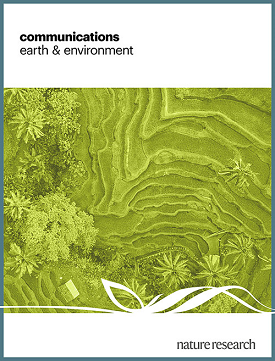印度洋偶极子通过刚果河排水加剧本格拉尼诺现象
IF 8.1
1区 地球科学
Q1 ENVIRONMENTAL SCIENCES
引用次数: 0
摘要
本格拉Niños是在非洲西南部海岸外的上升流区发生的不寻常的厄尔尼诺Niño-like变暖事件,对海洋生态系统、沿海渔业和区域天气产生了相应的影响。过去40年来最强的Benguela Niño发生在1995年2月至4月,安哥拉和纳米比亚海岸附近的当地海面温度异常高达4°C。在这里,我们展示了1994年9月至11月的强印度洋偶极子通过涉及刚果河流量的陆桥帮助增强了1995年本格拉Niño的振幅。我们使用大气、海洋和水文数据来证明印度洋偶极子发展、刚果河流域异常高降雨量、刚果河高流量、刚果河口附近低盐度以及这种低盐度水向南平流进入本格拉上升流区之间的序列联系。低盐度水将表层混合层与温跃层隔离,限制了与较冷的地下水的垂直混合,导致海表温度升温加剧。我们还讨论了其他印度洋偶极子事件如何类似地影响随后的本格拉Niños,以及印度洋偶极子对本格拉Niños的影响在未来可能变得更加突出的可能性。根据对海洋、大气和水文数据的分析,1995年的Benguela Niño是过去40年来最强的一次,由于1994年晚些时候印度洋偶极子发生,刚果河的淡水流量增加,使其加剧。本文章由计算机程序翻译,如有差异,请以英文原文为准。

Indian Ocean Dipole intensifies Benguela Niño through Congo River discharge
Benguela Niños are episodes of unusual El Niño-like warming in the upwelling zone off the coast of southwest Africa, with consequential impacts on marine ecosystems, coastal fisheries and regional weather. The strongest Benguela Niño in the past 40 years occurred in February–April 1995 with local sea surface temperature anomalies up to 4 °C off the coast of Angola and Namibia. Here, we show that a strong Indian Ocean Dipole in September–November 1994 helped boost the amplitude of the 1995 Benguela Niño through a land bridge involving Congo River discharge. We use atmospheric, oceanic, and hydrological data to demonstrate the sequential linkage between Indian Ocean Dipole development, unusually high rainfall in the Congo River basin, high Congo River discharge, low salinity near the Congo River mouth, and southward advection of this low salinity water into the Benguela upwelling region. The low salinity water isolated the surface mixed layer from the thermocline, which limited vertical mixing with colder subsurface waters and led to enhanced sea surface temperature warming. We also discuss how other Indian Ocean Dipole events may have similarly affected subsequent Benguela Niños and the possibility that Indian Ocean Dipole impacts on Benguela Niños may become more prominent in the future. The 1995 Benguela Niño, the strongest in the past 40 years, was intensified by high freshwater discharge from the Congo River due to a major Indian Ocean Dipole in late 1994, according to analysis of oceanic, atmospheric and hydrological data.
求助全文
通过发布文献求助,成功后即可免费获取论文全文。
去求助
来源期刊

Communications Earth & Environment
Earth and Planetary Sciences-General Earth and Planetary Sciences
CiteScore
8.60
自引率
2.50%
发文量
269
审稿时长
26 weeks
期刊介绍:
Communications Earth & Environment is an open access journal from Nature Portfolio publishing high-quality research, reviews and commentary in all areas of the Earth, environmental and planetary sciences. Research papers published by the journal represent significant advances that bring new insight to a specialized area in Earth science, planetary science or environmental science.
Communications Earth & Environment has a 2-year impact factor of 7.9 (2022 Journal Citation Reports®). Articles published in the journal in 2022 were downloaded 1,412,858 times. Median time from submission to the first editorial decision is 8 days.
 求助内容:
求助内容: 应助结果提醒方式:
应助结果提醒方式:


